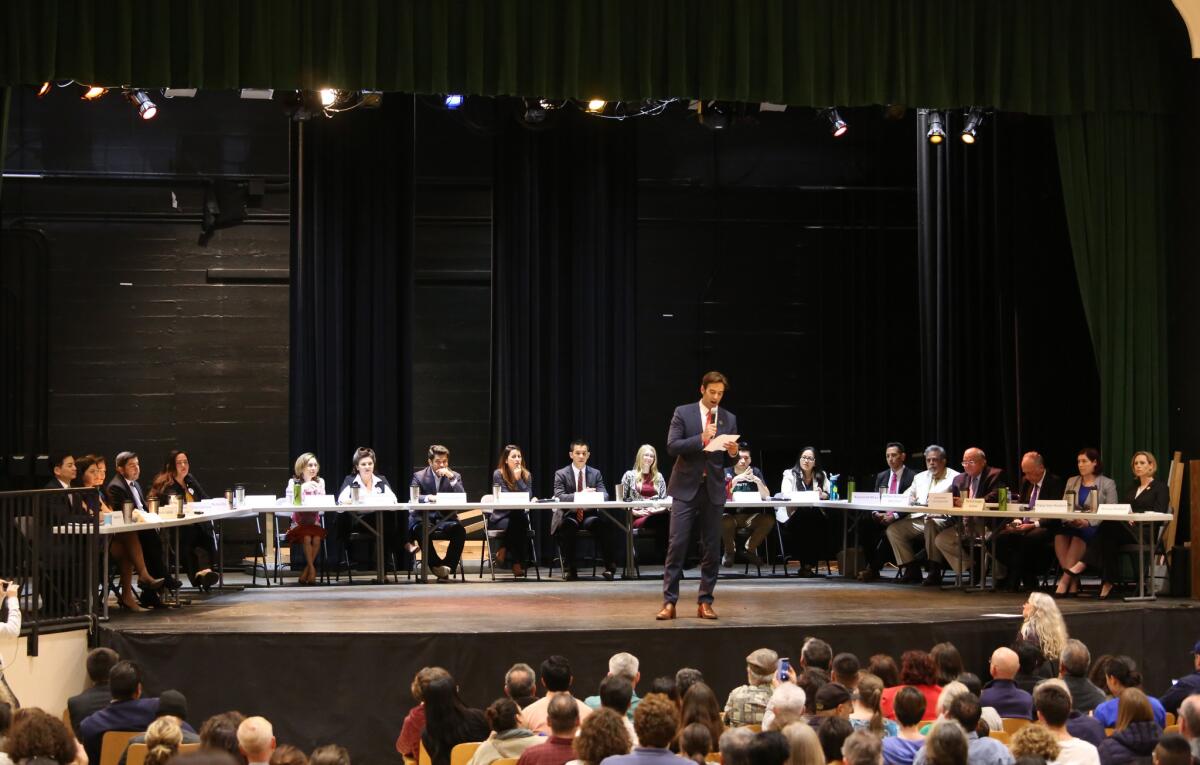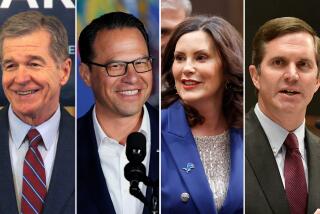The money race in L.A.’s congressional election: 5 candidates have gotten 75% of the cash

In the crowded field of two dozen candidates vying to replace Xavier Becerra in Congress, most of the money from donors has been flowing to a handful of hopefuls. Of the more than $2.4 million that has been raised by candidates since December, nearly 75% has gone to just five campaigns.
And in a race where local activists and community leaders dominate the field, an overwhelming majority of the money has come from outside the 34th Congressional District, which stretches from Koreatown and downtown Los Angeles to the more residential neighborhoods of Boyle Heights, Highland Park and Eagle Rock.
The latest fundraising and spending figures, released last week, give a fuller picture of which candidates are running viable campaigns to try to win the top two spots in the Tuesday primary in order to secure a spot in a likely June 6 runoff. (In the unlikely event that one candidate wins more than 50% of the vote, there won’t be a runoff.)
Here’s some of what we found:
The top five raised nearly three times the amount of the rest of the field combined
So far, donors have favored five candidates: Assemblyman Jimmy Gomez, Sara Hernandez, Robert Lee Ahn, Alejandra Campoverdi and Yolie Flores.
Not counting money candidates gave to themselves, Gomez was the top overall fundraiser, bringing in $540,360 since announcing his run in December. Hernandez, a former teacher who also worked as an L.A. City Hall aide, has raised $425,330 overall. But late entry Ahn, a former planning commissioner, out-raised both Hernandez and Gomez in the most recent campaign finance period, bringing in $330,300 in donations from Jan. 1 to March 15, putting him third in overall fundraising.
Most of the cash came from outside the district, and a lot of it came from outside California
According to a Times analysis of Federal Election Commission filings, more than 80% of the contributions where a ZIP Code was disclosed (which is most of them) came from areas outside the district.
Much of that money has been raised in more affluent parts of L.A. County, particularly the Westside. Those wealthy donors are trying to sway voters in an immigrant-heavy district where nearly half of the households earn less than $35,000 a year.
Some candidates have geographic strongholds. Gomez received a substantial share of his local money from northeast L.A., which he represents in the state Legislature, while more money from downtown L.A. has flowed to Hernandez than to many of the other candidates. Ahn, who would be the only Korean American in Congress if elected, has his strongest base in Koreatown, where his fundraising dwarfed the other candidates.
Campoverdi had a strong base of support from donors outside of California, where she raised 52% of her $262,737. She received more money from donors in New York state and Illinois than the $23,300 she raised from ZIP Codes inside the 34th District.
That could be chalked up to her itinerant resume: She attended Harvard and worked for President Obama’s campaign and later as a White House staffer before moving on to Univision News and the Los Angeles Times. (She left The Times last July.) Her largest donors range from Obama’s longtime aide Reggie Love to Shervin Pishevar, a venture capitalist and co-founder of the Los Angeles transportation start-up Hyperloop One.
Small-dollar donations play big role for some candidates
About $351,000, or 14% of all reported contributions, came from donors who gave less than $200. Arturo Carmona, Wendy Carrillo and Green Party candidate Kenneth Mejia, who are all vying for votes from the progressive wing of the Democratic Party heavily influenced by former presidential candidate Sen. Bernie Sanders, raised a lot from small donations.
Carmona, a former Sanders campaign advisor, raised the most in small donations, with $81,608, or about 46% of his overall total through March 15. Mejia, on the other hand, raised the largest share in small-dollar donations, about 90% of the $35,682 he raised in total.
Campoverdi raised $48,780 in donations of $200 or less, and Carrillo received $41,330 in small bucks.
The perks of being the establishment-backed candidate
Gomez has spent most of the race fighting the idea that he’s part of the Democratic Party establishment. But he’s benefited from that status, raising just under a third of all his contributions, or $167,090, from powerful political action committees.
Almost $45,000 of that came from fellow Sacramento legislators or their campaign committees, and state and local candidates. Healthcare industry committees and Native American gaming tribes have also contributed significant amounts to Gomez. And although registered California lobbyists are barred from giving money to his state Assembly campaign, Gomez received $10,400 worth of contributions to his U.S. congressional campaign from 10 registered lobbyists.
Playing to their strengths
For the rest of the top fundraising candidates, targeting their various bases of support was important. Maria Cabildo, a longtime affordable housing advocate, received a large share of contributions from employees of the East L.A. Community Corporation, the affordable housing development group she helped start, and others in the housing industry.
Hernandez, who worked as Councilman Jose Huizar’s downtown director, received donations from prominent downtown developers such as Geoff Anenberg and collected money from downtown chefs, including $1,500 from Neal Fraser of Redbird.
Flores, a former Los Angeles Board of Education member and social worker, received more than $30,000 from groups and advocates involved in charter schools, education groups and children’s issues.
How’d they spend it all?
The top fundraisers mostly spent their money on time-tested strategies, including mailers. Gomez spent $107,170 on stationery, direct mail and postage, which made up about 40% of his spending. Hernandez, the only candidate to spend a significant amount on TV ads so far, dropped $125,349 on media production and advertising, nearly half of her expenditures.
Campoverdi, who released an emotional ad highlighting her family’s history of breast cancer, spent a lean $35,711 on media buys, audio-video production and media consulting.
Ahn has spent a total of $352,538, including just over $168,000 on potholders, notepads, envelopes, printing, mailing and postage. He also spent just under $11,500 on other old-school tactics: door hangers, lawn signs and banners.
The candidates with their own skin in the game
Some of the lesser-known candidates new to politics are reaching into their own pockets.
Ahn loaned his campaign a staggering $295,000 and paid for another $8,400 in expenses out of his own pocket. Carmona loaned his campaign an additional $3,000 on top of $25,000 he had already forked over earlier in the race.
Tracy Van Houten spent $17,001 on her campaign, while Ricardo De La Fuente gave his campaign an initial loan of $8,591. A handful of other candidates, including Gomez, Hernandez, Flores and Raymond Meza, had previously donated to their own campaigns.
Money in the bank
Ahn’s massive loan to his own campaign left him in a competitive position for the final weeks of the campaign, with $271,200 in the bank. That’s just slightly behind Gomez, who has $274,830 left to spend, but well ahead of Hernandez, who has less than $141,000 banked.
Campoverdi has about $123,000 cash on hand, while Cabildo is trailing with less than $100,000 in the bank.
Those dollars could be crucial in the final days of the campaign, as candidates ramp up their get-out-the-vote operations and drop last-minute mailers and other ads as they try to capture voters’ attention.
As the election nears, federal law requires candidates to disclose such donations within 48 hours of receiving them.
Since March 15, Ahn has raised more than $103,000 in donations of $1,000 or more, so he likely has significantly more money to burn than the other candidates.
De La Fuente, a long-shot candidate who most recently worked for his father’s long-shot presidential campaign, loaned himself $40,000 in the last couple of weeks. Gomez has raised an extra $38,900 in big donations since mid-March, while Campoverdi added another $26,900 into her campaign coffers.
The full report of money raised and spent up until the day of the April 4 election won’t be available until a month later, when it’s likely the top two finishers in the primary will be far into their campaigns for the June 6 general election.
ALSO
Updates on California politics












